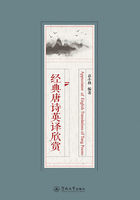
10.宿建德江
移舟泊烟渚,日暮客愁新。
野旷天低树,江清月近人。
中文解读
《宿建德江》是唐代诗人孟浩然的代表作之一。孟浩然,名浩,字浩然,号孟山人,襄阳人,世称孟襄阳。因他未曾入仕,又称为孟山人,是唐代著名的山水田园派诗人。
这是一首刻画秋江暮色的诗,是唐人五绝中的写景名篇。诗人把小船停靠在烟雾迷蒙的江边时想起了往事,因而以舟泊暮宿作为自己抒发感情的归宿,写出了自己的羁旅之思。第一句点题,也为下面写景抒情作了准备;第二句中“日暮”是“客愁新”的原因;最后两句,因为“野旷”所以天低于树,因为“江清”所以月能近人,天和树、人和月的关系,写得恰切逼真。此诗前两句为触景生情,后两句为借景抒情,描写了清新的秋夜,突出表现了细微的景物特点。
全诗淡而有味,含而不露,自然流出,风韵天成,颇有特色。
白话译文
把小船停靠在烟雾迷蒙的小洲,日暮时分新愁又涌上客子心头。
旷野无边无际远天比树还低沉,江水清清更觉月和人相亲相依。
英译一
Mooring on the River at Jiande
Translated by Xu Yuanchong
My boat is moored near an isle in mist grey,
I'm grieved anew to see the parting day.
On boundless plain trees seem to touch the sky,
In water clear the moon appears so nigh.
(isle n.小岛 grieve v.悲伤 anew adv.重新 boundless adj.无边的;广阔的 nigh adj.近的,直接的)
英译二
Lodge at Jiande River
Translated by Haiwai Yishi
Moving the boat to moor at the misty shoal,
As sun's setting, the tourist has new sorrows.
With fields so vast, the sky seems as low as trees,
With river so clear, the moon looks to me so close.
(shoal n.沙洲)
英译三
Passing the Night on a River in Jiande
Translated by Paul W. Kroll
I guide my boat to mooring by a misty islet,
With the setting sun, a traveler's sorrows revive.
The wilds so vast, the sky stoops to the trees,
The river so clear, the moon closes to man.
(islet n.小岛 revive v.恢复,再生 stoop v.弯腰,倾斜)
英译欣赏
The poem describes the sorrow of a traveler in a strange land with the mooring of his sailing boat at dusk as the background. “Low tress”and“wilderness”are set off each other, so are“clear river”and“close moon”.
这里选用了北京大学许渊冲教授、网友海外逸士和美国科罗拉多大学教授Paul W. Kroll 的译文。
英译一采用aabb押韵格式,英文描写和感觉都是从“我”而出。
My boat is moored near an isle in mist grey,句中mist grey本是grey mist,“烟渚”译为an isle in mist grey,形象贴切,“泊”译成my boat is moored,刚好表示停船的状态。
I'm grieved anew to see the parting day,看到离别的日子我又萌生了悲伤。grieve anew对译“愁新”,非常独到且准确。没有直译“日暮”,却用the parting day 表示离别日子到来,这是意译。
On boundless plain trees seem to touch the sky,在无边平地上的树木好像碰着了天空。这正是“野旷天低树”之意。
In water clear the moon appears so nigh,此为押韵倒装,应是:The moon appears so nigh in clear water。
英译二来自网上,海外逸士采用第三人称来叙述,“客”就是tourist。
Moving the boat to moor at the misty shoal,将“移”译为moving,其逻辑主语是tourist;将“洲”译为shoal(沙洲,浅滩)。
第三、四句用了两个with的复合结构,体现出对比和衔接。With fields so vast, the sky seems as low as trees, With river so clear, the moon looks to me so close,不过,前面是the tourist has new sorrows,这里似乎应保持一致。如果译为The moon looks to him so close似乎更好。
英译三为美国科罗拉多大学教授Paul W. Kroll 的翻译,其译文有着西方人表达的特点,更明了直接,是对等翻译。
I guide my boat to mooring by a misty islet,我引导小船停泊在被雾笼罩的小岛上。西方人似乎觉得要说清楚是怎样停船的。
With the setting sun, a traveler's sorrows revive。前面是I,这里又是a traveler,似乎出现两个人,也许是因为对原诗的理解不够。
后两句The wilds so vast和The river so clear 可以理解为独立主格结构作状语。The wilds so vast, the sky stoops to the trees, The river so clear, the moon close to man,也可理解为省略了系动词,相当于:The wilds are so vast, the sky stoops to the trees, The river is so clear, the moon closes to man。
思考
“烟渚”的“渚”,英文分别译为:isle, islet 和shoal,哪一个更接近原意?